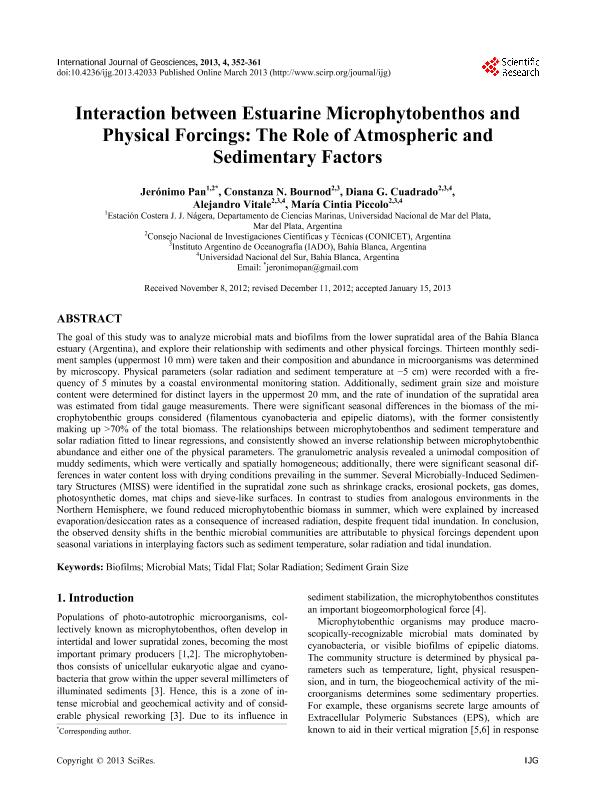Mostrar el registro sencillo del ítem
dc.contributor.author
Pan, Jeronimo

dc.contributor.author
Bournod, Constanza Naimé

dc.contributor.author
Cuadrado, Diana Graciela

dc.contributor.author
Vitale, Alejandro José

dc.contributor.author
Piccolo, Maria Cintia

dc.date.available
2017-01-16T15:27:00Z
dc.date.issued
2013-03
dc.identifier.citation
Pan, Jeronimo; Bournod, Constanza Naimé; Cuadrado, Diana Graciela; Vitale, Alejandro José; Piccolo, Maria Cintia; Interaction between estuarine microphytobenthos and physical forcings: the role of atmospheric and sedimentary factors; Scientific Research; International Journal of Geosciences; 4; 2; 3-2013; 352-361
dc.identifier.issn
2156-8359
dc.identifier.uri
http://hdl.handle.net/11336/11375
dc.description.abstract
The goal of this study was to analyze microbial mats and biofilms from the lower supratidal area of the Bahía Blanca estuary (Argentina), and explore their relationship with sediments and other physical forcings. Thirteen monthly sediment samples (uppermost 10 mm) were taken and their composition and abundance in microorganisms was determined by microscopy. Physical parameters (solar radiation and sediment temperature at -5 cm) were recorded with a frequency of 5 minutes by a coastal environmental monitoring station. Additionally, sediment grain size and moisture content were determined for distinct layers in the uppermost20 mm, and the rate of inundation of the supratidal area was estimated from tidal gauge measurements. There were significant seasonal differences in the biomass of the microphytobenthic groups considered (filamentous cyanobacteria and epipelic diatoms), with the former consistently making up >70% of the total biomass. The relationships between microphytobenthos and sediment temperature and solar radiation fitted to linear regressions, and consistently showed an inverse relationship between microphytobenthic abundance and either one of the physical parameters. The granulometric analysis revealed a unimodal composition of muddy sediments, which were vertically and spatially homogeneous; additionally, there were significant seasonal differences in water content loss with drying conditions prevailing in the summer. Several Microbially-Induced Sedimentary Structures (MISS) were identified in the supratidal zone such as shrinkage cracks, erosional pockets, gas domes, photosynthetic domes, mat chips and sieve-like surfaces. In contrast to studies from analogous environments in the Northern Hemisphere, we found reduced microphytobenthic biomass in summer, which were explained by increased evaporation/desiccation rates as a consequence of increased radiation, despite frequent tidal inundation. In conclusion, the observed density shifts in the benthic microbial communities are attributable to physical forcings dependent upon seasonal variations in interplaying factors such as sediment temperature, solar radiation and tidal inundation.
dc.format
application/pdf
dc.language.iso
eng
dc.publisher
Scientific Research
dc.rights
info:eu-repo/semantics/openAccess
dc.rights.uri
https://creativecommons.org/licenses/by-nc-sa/2.5/ar/
dc.subject
Biofilms
dc.subject
Microbial Mats
dc.subject
Tidal Flat
dc.subject
Solar Radiation
dc.subject
Sediment Grain Size
dc.subject.classification
Oceanografía, Hidrología, Recursos Hídricos

dc.subject.classification
Ciencias de la Tierra y relacionadas con el Medio Ambiente

dc.subject.classification
CIENCIAS NATURALES Y EXACTAS

dc.title
Interaction between estuarine microphytobenthos and physical forcings: the role of atmospheric and sedimentary factors
dc.type
info:eu-repo/semantics/article
dc.type
info:ar-repo/semantics/artículo
dc.type
info:eu-repo/semantics/publishedVersion
dc.date.updated
2016-12-01T19:38:35Z
dc.journal.volume
4
dc.journal.number
2
dc.journal.pagination
352-361
dc.journal.pais
Estados Unidos

dc.description.fil
Fil: Pan, Jeronimo. Universidad Nacional de Mar del Plata. Facultad de Ciencias Exactas y Naturales. Departamento de Ciencias Marinas; Argentina. Consejo Nacional de Investigaciones Científicas y Técnicas; Argentina
dc.description.fil
Fil: Bournod, Constanza Naimé. Consejo Nacional de Investigaciones Científicas y Técnicas. Centro Científico Tecnológico Bahía Blanca. Instituto Argentino de Oceanografía (i); Argentina
dc.description.fil
Fil: Cuadrado, Diana Graciela. Consejo Nacional de Investigaciones Científicas y Técnicas. Centro Científico Tecnológico Bahía Blanca. Instituto Argentino de Oceanografía (i); Argentina. Universidad Nacional del Sur; Argentina
dc.description.fil
Fil: Vitale, Alejandro José. Consejo Nacional de Investigaciones Científicas y Técnicas. Centro Científico Tecnológico Bahía Blanca. Instituto Argentino de Oceanografía (i); Argentina. Universidad Nacional del Sur; Argentina
dc.description.fil
Fil: Piccolo, Maria Cintia. Consejo Nacional de Investigaciones Científicas y Técnicas. Centro Científico Tecnológico Bahía Blanca. Instituto Argentino de Oceanografía (i); Argentina. Universidad Nacional del Sur; Argentina
dc.journal.title
International Journal of Geosciences
dc.relation.alternativeid
info:eu-repo/semantics/altIdentifier/url/http://www.scirp.org/journal/PaperInformation.aspx?PaperID=29337
dc.relation.alternativeid
info:eu-repo/semantics/altIdentifier/doi/http://dx.doi.org/10.4236/ijg.2013.42033
Archivos asociados
